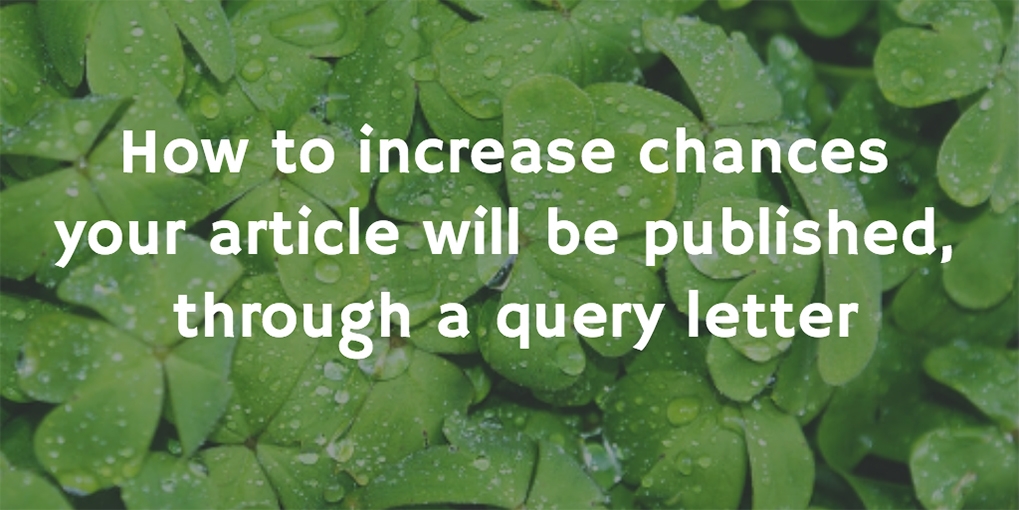Have you ever spent hours – or days – writing an article for an online or print publication, sent it to the editor, and you never even heard back? It’s frustrating and discouraging. Yet you look through trade or professional magazines, or the websites of influential associations, and you see other “expert-written” articles – perhaps by people whose names you recognize. What do they know about this getting-published-business that you don’t?
Here’s how to boost your chances of publishing articles successfully, and of not wasting your time writing something that won’t get published.
To do this, take a leaf from a freelance writer’s book. Get the editor “sold” on your idea before you sit down to write the article, by means of a “query letter.” A query is a mini-proposal for a write-up, sent to the editor before the item is written. Here’s why it matters.
Why editors like a query letter
Think of the process from the publisher’s point of view. Editors are very busy people. They don’t have time to wade through a pile of “unsolicited manuscripts,” which is editor-speak for articles they didn’t ask for.
Publishers know that many of those articles are mass-produced, not specific to their readers, and may have been published elsewhere. That’s why they usually won’t respond to articles from writers they haven’t heard of before.
But remember that editors depend on getting content from subject-matter experts like you are. They need your in-the-trenches experience for their readers. Many editors these days have tight budgets for commissioning freelance writers. So they need content that’s relevant to their readers, and for which they don’t pay. Yes, they want to hear from you – but only in the right way.
Give your article a head start with the editor
Get your article off on the right foot in the race to get published, by presenting your idea to the editor before you write the article. That way, she or he may be able to say something like, “Sounds interesting – but we’ve covered that topic recently. But if you drilled down into a more focused look at one aspect of that topic, that would work for us.”
So, taking the extra step of writing a query letter – an article proposal -- has saved you from writing an article that won’t get published – and heightened your chances that your topic will be useful to the publication’s readers. It has increased the outlook that your article will help you become known. It helps you to get known for solving issues that your potential clients are actually facing.
I’ve talked with dozens of editors over the years, and they all seem to like the query letter outline I’ve set out below.
Designing a query letter that pre-sells your idea
There are four points in an effective query letter.
- Your topic: State the topic you want to write about, concisely – in one or two sentences. You don’t need more than that - be brief.
- Why readers would care about the topic: All publications have a specific area of focus. Editors want content that relates to that particular focus. Many editors are tired of getting content that is irrelevant to their readers. Probably it wasn’t written with these readers’ issues in mind. Show that you comprehend this, by discussing what you understand of the readers’ concerns and issues.
- A point-form outline: The editor wants to know what the article will look like, so develop an outline, with three or four points of about a line each. You don’t need an elaborate prospectus or abstract for the article. Keep it short and clear.
- Writer’s qualifications: The editor wants to be assured that you’re competent to discuss your chosen topic. Exhibit your academic and relevant professional qualifications, and add experiences in your field.
Send that query to the editor, addressed by name. You’ll probably need to follow up with a phone call in a few days, and be ready to discuss your article idea verbally.
Success factors in presenting an article concept to an editor
Read the publication first. Generally, you can find some content, even if it’s not the most recent issue, on the website. Editors want content that’s relevant to their readers, and many trade publications are breathtakingly narrow in their focus. For example, “Power” magazine focuses on the generation of electrical power – it doesn’t cover transmission or distribution. Just generation. If you go to the editor with a story idea on transmission, it won’t get accepted.
In your query, be able to refer specifically to something you read in a recent issue of the magazine. This is how you prove to the editor that you’ve read it. Best of all: refer to something in the editor’s editorial. Like any other writer, editors like to know that someone is reading their writing. So, be able to write, “This article would be in support of one of the points in your most recent editorial, about how the industry needs to pay more attention to…”
If you call the editor to follow up on your query, first introduce yourself and then say something like, “I’m calling to follow up on a query about (your topic, in about three words). Is this a good time to discuss it?” If the editor says it’s not a good time, ask if you can call back. The editor will appreciate it – and anyway, if the publisher is focused on finishing off the current issue, you won’t get their full brain engaged in discussion of another topic in any case. Be considerate and smart – call back.
In future posts, I’ll talk about how to build a good relationship with an editor, so you can go on showing your expertise.


